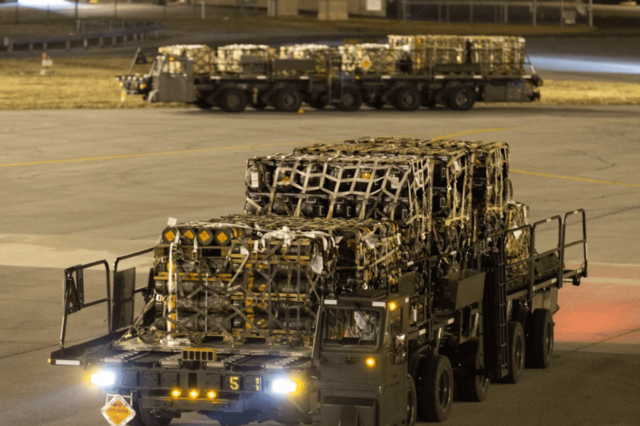
US rushes $800M in weapons, helicopters to Ukraine as Russia coils for new offensive Airman 1st Class Stephen Knotts, 436th Aerial Port Squadron ramp services apprentice, drives a cargo loader with palletized ammunition, weapons and other equipment bound for Ukraine during a foreign military sales mission at Dover Air Force Base, Delaware, Jan. 24, 2022. (U.S. Air Force photo by Roland Balik)
The United States will send an $800 million security assistance package of additional military weapons systems, vehicles, and munitions to Ukraine as Russia prepares to significantly increase its assault on the Donbas region, President Joe Biden announced Wednesday.
The latest arms transfer will include 11 Mi-17 helicopters that the administration had originally planned for Afghanistan but will send to Ukraine instead. The package also includes
18 155mm Howitzers, 300 Switchblade drones, 200 M113 armored personnel carriers, and 100 armored high-mobility multipurpose wheeled vehicles.
The new capabilities are “tailored to the wider assault we expect Russia to launch in eastern Ukraine,” Biden said in a statement.
Since Russia launched its invasion in February, the Biden administration has declined to send aircraft out of concern that Russia would see it as escalatory.
“We committed from the very beginning, even before the invasion, to helping Ukraine be able to defend itself,” Pentagon Press Secretary John Kirby said at a briefing Wednesday, when asked whether the helicopters would be seen as escalatory.
“How that gets interpreted by the Russians, you can ask [Russian leader Vladimir] Putin and the Kremlin. What we’re concerned about is making sure that we are doing what we said we were going to do.”
Kirby said the administration is still concerned about any potential escalation with nuclear-armed Russia.
“Every decision we’re making, we balance the needs of Ukraine to defend itself with our responsibilities—our absolute responsibilities—to think about escalation management,” Kirby said.
The United States also is sending 10 AN/TPQ-36 counter-artillery radars, and two phased array AN/MPQ-64 Sentinel Air Surveillance radars that the Ukrainians have not previously received from the United States and could require additional training, he added.
Biden said this latest tranche of military assistance “has been critical in sustaining its fight against the Russian invasion.”
But there’s significant concern in the Pentagon that Russia’s recent moves to concentrate its forces in the east, where they can be resupplied more easily, portends an even more brutal phase of the war is on the horizon, and there was a sense of urgency to get the Ukrainians the weapons they’ve been asking for before it is too late.
“Without additional weaponry, this war will become an endless bloodbath, spreading misery, suffering, and destruction. Mariupol, Bucha, Kramatorsk—the list will be continued. Nobody will stop Russia except Ukraine with Heavy Weapons,” Ukrainian President Volodymyr Zelenskyy tweeted Wednesday.
Russia is staging helicopters, artillery systems, and additional troops to prepare for a major assault in the Donbas, while the United States is pushing additional weaponry “as fast as we can” to help Ukraine survive that onslaught, a senior defense official said earlier.
The latest round of military aid “can be in the Ukrainian hands in as little as 48 hours, sometimes faster,” a senior defense official told reporters at the Pentagon earlier Wednesday. Deputy Defense Secretary Kathleen Hicks had said Tuesday that the administration was considering getting longer-range weapons to Ukraine to supplement the thousands of Javelin anti-tank weapons and Stinger anti-aircraft missiles it’s already sent. Wednesday’s announced arms package included 500 additional Javelins.
Russia has scaled back its air campaign recently, from a high of as many as 300 sorties a day to now an estimated 150 sorties a day—almost all of which are concentrating their airstrikes on Mariupol and the Donbas region.
To date, the United States has provided Ukraine more than $3.2 billion in security assistance since President Joe Biden took office, including ammunition, drones, missiles, and anti-tank weapons; $2.5 billion since Russia invaded in February.
___
© 2022 Government Executive Media Group LLC Distributed by Tribune Content Agency, LLC




